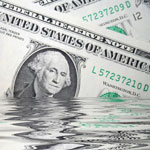The True Products of Quantitative Easing
05/31/11 Baltimore, Maryland – While we were traveling around the globe, the data continued to come in. It offered no surprises. Instead, it was more of the same. Housing is in a bitter slump, with prices down more than 30% nationwide and now falling at about 1% per month.
Unemployment remains a problem area. Officially, the unemployment rate is around 9%. But the real rate of joblessness, according to Yale professor Robert Shiller, is closer to 16%. New jobs are being created. But there are not enough of them to keep up with population growth and allow the unemployed to get back to work.
Another problem is that the jobs being created tend to be in government, government-sponsored businesses, or other low-productivity, low-wage activities.
You can earn money parking cars, for example. But not very much. Nor does parking a car contribute much to standards of living. So real wages go down. Wages increased by 1.9% over the last year; that was exactly equal to the official estimate of price increases. But prices are rising faster than the official CPI, as we’ll explain in a moment.
Meanwhile, the feds have completely failed. The figures we reported last week showed that the ‘recovery’ efforts had totally washed up. Each job ‘created’ by quantitative easing, for example, cost more than $800,000. Assuming the average wage is about $40,000, this means the program destroyed the equivalent of 20 jobs for every one it created.
Instead of creating jobs, the Fed’s QE program created inflation – especially in the price of energy. Family budgets suffer. Here’s an AP report:
NEW YORK (AP) – There’s less money this summer for hotel rooms, surfboards and bathing suits. It’s all going into the gas tank.
High prices at the pump are putting a squeeze on the family budget as the traditional summer driving season begins. For every $10 the typical household earns before taxes, almost a full dollar now goes toward gas, a 40 percent bigger bite than normal.
Households spent an average of $369 on gas last month. In April 2009, they spent just $201. Families now spend more filling up than they spend on cars, clothes or recreation. Last year, they spent less on gasoline than each of those things.
The ramifications are far-reaching for an economy still struggling to gain momentum two years into a recovery. Economists say the gas squeeze makes people feel poorer than they actually are.
They’re showing it by limiting spending far beyond the gas station. Wal-Mart recently blamed high gas prices for an eighth straight quarter of lower sales in the US. Target said gas prices were hurting sales of clothes.
Every 50-cent jump in the cost of gasoline takes $70 billion out of the US economy over the course of a year, Hamilton says. That’s about one half of one percent of gross domestic product.
The latest GDP numbers show ‘growth’ happening at the rate of 1.8% per year. But, like everything else the feds report, the figures are probably little more than wishful thinking and bald-faced lies. In order to come up with a GDP growth number, the feds take the raw figures and then subtract inflation to come up with ‘real’ GDP growth.
The number they use to ‘deflate’ GDP is their annual CPI-U figure 1.9%. But the first quarter of this year showed prices rising much faster, with a CPI-U figure annualized to 5.7%. We won’t even mention the higher figure provided by the Billion Prices Project. In other words, if they applied their own inflation number for the first quarter, to their own GDP number for the first quarter, US GDP would not be going up at all. It would be going down at a 1.8% rate.

No comments:
Post a Comment